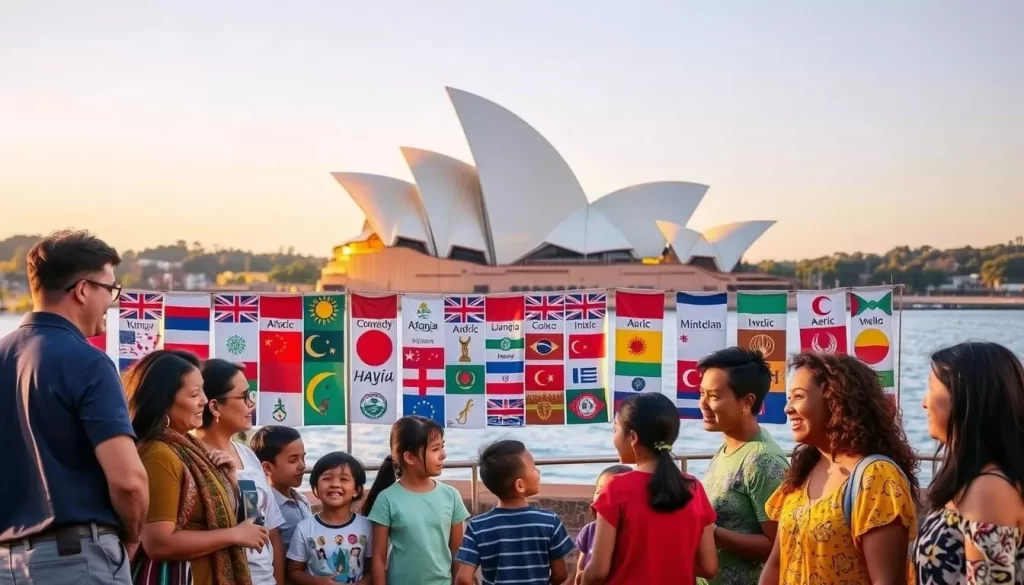✓ Accommodations ✓ Flights ✓ Rental Cars
New South Wales is a hub of cultural diversity, reflected in its rich linguistic tapestry. In 2021, over 26% of the population spoke a language other than English at home, showcasing the state’s multicultural identity. This makes it one of the most linguistically diverse regions, with more than 300 spoken languages across its communities.
Understanding this diversity is essential for both residents and visitors. It highlights the importance of embracing different cultures and languages in everyday life. The 2021 census data reveals a significant shift, with fewer people speaking only English at home compared to previous years.
This section sets the stage for a deeper exploration of the state’s linguistic landscape. You’ll discover how this diversity shapes the community and why it matters. Stay tuned to learn more about the top languages spoken and their impact on the region.
Exploring NSW’s Rich Linguistic Landscape
The linguistic landscape of NSW is a vibrant reflection of its multicultural roots. Over 275 languages are spoken across the state, making it a hub of cultural exchange. This diversity is not just about numbers—it’s about the stories, traditions, and connections each language brings to the community.

Understanding Cultural Diversity in NSW
NSW’s cultural diversity is evident in its spoken languages. From Mandarin to Arabic, each language represents a unique community. For example, the 2021 census shows a significant increase in Nepali speakers, while Greek and Italian speakers have declined.
Migration patterns play a key role in shaping these trends. As new communities grow, so does the number of speakers for specific languages. This shift highlights the dynamic nature of NSW’s linguistic identity.
Historical Shifts in Language Trends
Historical data reveals fascinating changes in language use. Between 2016 and 2021, some languages saw a surge in speakers, while others experienced a decline. These shifts reflect broader social and demographic changes.
For instance, the rise in Nepali speakers can be linked to increased immigration from Nepal. On the other hand, the drop in Greek and Italian speakers suggests a generational change as younger generations adopt English at home.
Understanding these trends helps us appreciate the evolving nature of language in NSW. It also underscores the importance of supporting linguistic diversity in schools, workplaces, and public services.
New South Wales, Australia: Official and widely spoken languages
Language trends in NSW reveal a dynamic and evolving cultural landscape. The 2021 census provides a detailed snapshot of the top languages spoken across the state, reflecting its multicultural identity.
Top 10 Languages from the 2021 Census
According to the latest data, Mandarin leads as the most spoken language after English, with 3.4% of the population using it at home. Arabic follows closely at 2.8%, while Cantonese and Vietnamese round out the top five.

Other prominent languages include Hindi, Greek, Spanish, Nepali, and Italian. Nepali, in particular, saw a significant rise in speakers, reflecting recent immigration trends.
Comparing 2016 and 2021 Language Data
When comparing the 2016 and 2021 census data, some languages show remarkable growth. For instance, Nepali speakers increased by over 60%, while Hindi also saw a notable rise.
On the other hand, Greek and Italian experienced declines, likely due to generational shifts as younger speakers adopt English at home. These changes highlight the evolving nature of language use in NSW.
Understanding these trends helps policymakers and communities adapt to the needs of a diverse population. It also underscores the importance of preserving and promoting linguistic diversity.
The Impact of Immigration on Language Diversity
Immigration has played a pivotal role in shaping the linguistic diversity of the region. The influx of migrants has introduced new languages, enriching the cultural fabric. For example, the number of Nepali speakers surged by over 60% between 2016 and 2021, reflecting recent migration trends.

This growth is not limited to Nepali. Languages like Hindi and Punjabi have also seen significant increases, driven by immigration from South Asia. These changes highlight the dynamic nature of the region’s language landscape.
Emerging Language Trends and Growth
Recent census data reveals fascinating shifts in language use. Mandarin remains the most spoken language after English, with 3.4% of the population using it at home. Arabic and Vietnamese follow closely, reflecting the region’s multicultural identity.
Here’s a breakdown of the top emerging languages:
| Language | Speakers (2021) | Growth Since 2016 |
|---|---|---|
| Nepali | 133,068 | 60% |
| Hindi | 197,132 | 25% |
| Punjabi | 239,033 | 20% |
Community Challenges and Support Initiatives
While immigration has enriched the language landscape, it also brings challenges. Older migrants, particularly from Greek and Italian communities, often face language barriers. These challenges can affect access to essential services and social integration.
Support initiatives are crucial in addressing these issues. Programs like language assistance services help bridge the gap. Additionally, culturally appropriate resources ensure that diverse communities receive the support they need.
Understanding these trends and challenges helps policymakers and communities adapt to the needs of a diverse population. It also underscores the importance of preserving and promoting linguistic diversity.
Conclusion
The region’s linguistic diversity is a testament to its evolving cultural identity. The 2021 census highlights significant shifts, with Mandarin and Arabic leading as the most spoken languages after English. Nepali speakers saw a remarkable rise, reflecting recent immigration trends.
These changes underscore the dynamic nature of the community. While some languages grew, others like Greek and Italian declined, showing generational shifts. Understanding these trends helps in supporting diverse populations.
Programs like community language initiatives play a crucial role in bridging gaps. They ensure everyone has access to essential resources.
Stay informed about these language trends. Explore more to understand how they shape the region’s future. For deeper insights, check out this detailed analysis.
The above is subject to change.
Check back often to TRAVEL.COM for the latest travel tips and deals.






